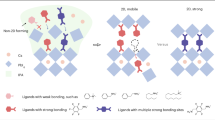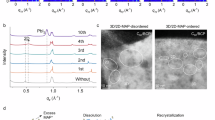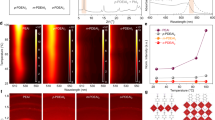Abstract
Two-dimensional (2D) and three-dimensional (3D) perovskite heterostructures have played a key role in advancing the performance of perovskite solar cells1,2. However, the migration of cations between 2D and 3D layers results in the disruption of octahedral networks, leading to degradation in performance over time3,4. We hypothesized that perovskitoids, with robust organic–inorganic networks enabled by edge- and face-sharing, could impede ion migration. We explored a set of perovskitoids of varying dimensionality and found that cation migration within perovskitoid–perovskite heterostructures was suppressed compared with the 2D–3D perovskite case. Increasing the dimensionality of perovskitoids improves charge transport when they are interfaced with 3D perovskite surfaces—this is the result of enhanced octahedral connectivity and out-of-plane orientation. The 2D perovskitoid (A6BfP)8Pb7I22 (A6BfP: N-aminohexyl-benz[f]-phthalimide) provides efficient passivation of perovskite surfaces and enables uniform large-area perovskite films. Devices based on perovskitoid–perovskite heterostructures achieve a certified quasi-steady-state power conversion efficiency of 24.6% for centimetre-area perovskite solar cells. We removed the fragile hole transport layers and showed stable operation of the underlying perovskitoid–perovskite heterostructure at 85 °C for 1,250 h for encapsulated large-area devices in ambient air.
This is a preview of subscription content, access via your institution
Access options
Access Nature and 54 other Nature Portfolio journals
Get Nature+, our best-value online-access subscription
$32.99 / 30 days
cancel any time
Subscribe to this journal
Receive 51 print issues and online access
$199.00 per year
only $3.90 per issue
Buy this article
- Purchase on SpringerLink
- Instant access to full article PDF
Prices may be subject to local taxes which are calculated during checkout




Similar content being viewed by others
Data availability
The data supporting the findings of this study are available from the corresponding authors upon request. All the crystal structure files generated in this study have been deposited at the Cambridge Crystallographic Data Centre under the accession numbers 2362695, 2362696, 2362697, 2362698, 2362699, 2362700, 2362701 and 2362702.
References
Grancini, G. et al. One-year stable perovskite solar cells by 2D/3D interface engineering. Nat. Commun. 8, 15684 (2017).
Sidhik, S. et al. Deterministic fabrication of 3D/2D perovskite bilayer stacks for durable and efficient solar cells. Science 377, 1425–1430 (2022).
Luo, L. et al. Stabilization of 3D/2D perovskite heterostructures via inhibition of ion diffusion by cross-linked polymers for solar cells with improved performance. Nat. Energy 8, 294–303 (2023).
Szabó, G. & Kamat, P. V. How cation migration across a 2D/3D interface dictates perovskite solar cell efficiency. ACS Energy Lett. 9, 193–200 (2024).
Liu, C. et al. Bimolecularly passivated interface enables efficient and stable inverted perovskite solar cells. Science 382, 810–815 (2023).
Chen, H. et al. Improved charge extraction in inverted perovskite solar cells with dual-site-binding ligands. Science 384, 189–193 (2024).
Zhao, Y. et al. Inactive (PbI2)2RbCl stabilizes perovskite films for efficient solar cells. Science 377, 531–534 (2022).
Perini, C. A. R. et al. Interface reconstruction from Ruddlesden–Popper structures impacts stability in lead halide perovskite solar cells. Adv. Mater. 34, 2204726 (2022).
Chakkamalayath, J., Hiott, N. & Kamat, P. V. How stable is the 2D/3D interface of metal halide perovskite under light and heat? ACS Energy Lett. 8, 169–171 (2023).
Liu, C. et al. Tuning structural isomers of phenylenediammonium to afford efficient and stable perovskite solar cells and modules. Nat. Commun. 12, 6394 (2021).
Park, S. M. et al. Engineering ligand reactivity enables high-temperature operation of stable perovskite solar cells. Science 381, 209–215 (2023).
Jiang, Y. et al. Synthesis-on-substrate of quantum dot solids. Nature 612, 679–684 (2022).
Li, X. et al. Three-dimensional lead iodide perovskitoid hybrids with high X-ray photoresponse. J. Am. Chem. Soc. 142, 6625–6637 (2020).
Gao, L. et al. Improved environmental stability and solar cell efficiency of (MA,FA)PbI3 perovskite using a wide-band-gap 1D thiazolium lead iodide capping layer strategy. ACS Energy Lett. 4, 1763–1769 (2019).
Semerci, A. et al. A novel multi-functional thiophene-based organic cation as passivation, crystalline orientation, and organic spacer agent for low-dimensional 3D/1D perovskite solar cells. Adv. Opt. Mater. 11, 2300267 (2023).
Chen, J. et al. Highly efficient and stable perovskite solar cells enabled by low-dimensional perovskitoids. Sci. Adv. 8, eabk2722 (2022).
Kong, T. et al. Perovskitoid-templated formation of a 1D@3D perovskite structure toward highly efficient and stable perovskite solar cells. Adv. Energy Mater. 11, 2101018 (2021).
Wang, H. et al. Water stable haloplumbate modulation for efficient and stable hybrid perovskite photovoltaics. Adv. Energy Mater. 11, 2101082 (2021).
Miao, Y. et al. Green solvent enabled scalable processing of perovskite solar cells with high efficiency. Nat. Sustain. 6, 1465–1473 (2023).
Zhang, F. et al. Surface lattice engineering through three-dimensional lead iodide perovskitoid for high-performance perovskite solar cells. Chem 7, 774–785 (2021).
Li, X., Hoffman, J. M. & Kanatzidis, M. G. The 2D halide perovskite rulebook: how the spacer influences everything from the structure to optoelectronic device efficiency. Chem. Rev. 121, 2230–2291 (2021).
Mao, L., Stoumpos, C. C. & Kanatzidis, M. G. Two-dimensional hybrid halide perovskites: principles and promises. J. Am. Chem. Soc. 141, 1171–1190 (2019).
Kamminga, M. E. et al. Confinement effects in low-dimensional lead iodide perovskite hybrids. Chem. Mater. 28, 4554–4562 (2016).
Ansari, F. et al. Passivation mechanism exploiting surface dipoles affords high-performance perovskite solar cells. J. Am. Chem. Soc. 142, 11428–11433 (2020).
Kim, H. et al. Self-crystallized multifunctional 2D perovskite for efficient and stable perovskite solar cells. Adv. Funct. Mater. 30, 1910620 (2020).
Yang, Y. et al. Universal approach toward high-efficiency two-dimensional perovskite solar cells via a vertical-rotation process. Energy Environ. Sci. 13, 3093–3101 (2020).
Cho, K. T. et al. Selective growth of layered perovskites for stable and efficient photovoltaics. Energy Environ. Sci. 11, 952–959 (2018).
Gao, P., Bin Mohd Yusoff, A. R. & Nazeeruddin, M. K. Dimensionality engineering of hybrid halide perovskite light absorbers. Nat. Commun. 9, 5028 (2018).
Hoye, R. L. Z. et al. The role of dimensionality on the optoelectronic properties of oxide and halide perovskites, and their halide derivatives. Adv. Energy Mater. 12, 2100499 (2022).
Hartono, N. T. P. et al. The effect of structural dimensionality on carrier mobility in lead-halide perovskites. J. Mater. Chem. A 7, 23949–23957 (2019).
Niu, T. et al. Interfacial engineering at the 2D/3D heterojunction for high-performance perovskite solar cells. Nano Lett. 19, 7181–7190 (2019).
Zhao, R. et al. Rigid conjugated diamine templates for stable Dion–Jacobson-type two-dimensional perovskites. J. Am. Chem. Soc. 143, 19901–19908 (2021).
Peng, J. et al. Centimetre-scale perovskite solar cells with fill factors of more than 86 per cent. Nature 601, 573–578 (2022).
Li, J. et al. Enhancing the efficiency and longevity of inverted perovskite solar cells with antimony-doped tin oxides. Nat. Energy https://doi.org/10.1038/s41560-023-01442-1 (2024).
Zhou, J. et al. Highly efficient and stable perovskite solar cells via a multifunctional hole transporting material. Joule https://doi.org/10.1016/j.joule.2024.02.019 (2024).
Shi, P. et al. Oriented nucleation in formamidinium perovskite for photovoltaics. Nature 620, 323–327 (2023).
Ding, Y. et al. Single-crystalline TiO2 nanoparticles for stable and efficient perovskite modules. Nat. Nanotechnol. 17, 598–605 (2022).
Liu, C. et al. Retarding solid-state reactions enable efficient and stable all-inorganic perovskite solar cells and modules. Sci. Adv. 9, eadg0087 (2023).
Yang, Y. et al. A thermotropic liquid crystal enables efficient and stable perovskite solar modules. Nat. Energy 9, 316–323 (2024).
Zhao, Y. et al. A bilayer conducting polymer structure for planar perovskite solar cells with over 1,400 hours operational stability at elevated temperatures. Nat. Energy 7, 144–152 (2022).
Acknowledgements
This work is partially supported by award 70NANB19H005 from the US Department of Commerce, National Institute of Standards and Technology as part of the Center for Hierarchical Materials Design (CHiMaD). M.G.K. was supported by DOE BES grant no. DE-SC0024422 (fundamental studies on metal halides) and T.J.M. by ONR award no. N00014-20-1-2116. This work made use of the SPID, EPIC, Keck-II and NUFAB facilities of Northwestern University’s NUANCE Center, which has received support from the SHyNE Resource (NSF ECCS-2025633), the International Institute of Nanotechnology, Northwestern University and Northwestern’s MRSEC programs (NSF DMR-1720139, NSF DMR-2308691). A.S.R.B. acknowledges support from King Abdullah University of Science and Technology (KAUST) through the Ibn Rushd Postdoctoral Fellowship Award.
Author information
Authors and Affiliations
Contributions
C.L., Y.Y. and D.Z. conceived the idea and proposed the experimental design. C.L. and Y.Y. conducted the characterization. C.L., Y.Y. and H.C. performed the device fabrication. I.S. performed single-crystal synthesis, characterization and structure analysis. C.L. and A.S.R.B. wrote the first draft of the manuscript. A.S.R.B. performed the SEM and XRD measurements. J.C. synthesized organic halides. B.V. and S.D.W. conducted the TEM measurements. I.W.G., R.P.R., T.E.W. and J.F. helped with the single-crystal synthesis and structure analysis. C.H. and Y.L. helped with photoluminesence measurements. A.M., Z.W., B.C. and L.X.C. helped revise the manuscript. D.Z., T.J.M., A.F., E.H.S. and M.G.K. supervised the project. All the authors contributed to comments on and revision of the manuscript.
Corresponding authors
Ethics declarations
Competing interests
C.L., Y.Y., I.S., B.C., D.Z., A.F., T.J.M., E.H.S. and M.G.K. are filing a patent based on this work. The other authors declare no competing interests.
Peer review
Peer review information
Nature thanks Dongqin Bi, Naeimeh Mozaffari and the other, anonymous, reviewer(s) for their contribution to the peer review of this work. Peer reviewer reports are available.
Additional information
Publisher’s note Springer Nature remains neutral with regard to jurisdictional claims in published maps and institutional affiliations.
Supplementary information
Supplementary Information
This file contains Supplementary text, Figs. 1–29, Tables 1–11 and references 1–21.
Rights and permissions
Springer Nature or its licensor (e.g. a society or other partner) holds exclusive rights to this article under a publishing agreement with the author(s) or other rightsholder(s); author self-archiving of the accepted manuscript version of this article is solely governed by the terms of such publishing agreement and applicable law.
About this article
Cite this article
Liu, C., Yang, Y., Chen, H. et al. Two-dimensional perovskitoids enhance stability in perovskite solar cells. Nature 633, 359–364 (2024). https://doi.org/10.1038/s41586-024-07764-8
Received:
Accepted:
Published:
Issue date:
DOI: https://doi.org/10.1038/s41586-024-07764-8
This article is cited by
-
Suppressing electron–phonon coupling for narrow-band emitting Eu(II)-based perovskitoids
Nature Communications (2025)
-
Enhancing hole-conductor-free, printable mesoscopic perovskite solar cells through post-fabrication treatment via electrophilic reaction
Nature Energy (2025)
-
Impact of lithium dopants in hole-transporting layers on perovskite solar cell stability under day–night cycling
Nature Energy (2025)
-
Selective templating growth of chemically inert low-dimensional interfaces for perovskite solar cells
Nature Energy (2025)
-
Graphene oxide-enhanced inverted MAPbI3 perovskite solar cells: improvements in efficiency and long-term stability
Journal of Materials Science: Materials in Electronics (2025)



